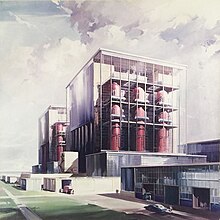Claude Buckle
He attended Grammar school in Wolverhampton and on leaving in 1922 joined J. S. Fry & Sons Chocolates in Bristol as an assistant architect.
In 1926, at the age of 21, Buckle moved to London where he joined Wallis, Gilbert and Partners responsible for building the Ford factories at Dagenham.
In 1930, after submitting four drawings, became one of the youngest amateur members of the British Savages Art Group[2] based in Bristol.
He travelled in France, Spain and North Africa using Tramp Steamers recording scenes that later formed many of the ideas for his watercolour paintings.
However, when the work started to dry up in 1963, following the Beeching Axe, Buckle relied more and more on the private market place to earn a living.
Buckle spent the last years of the war in Northern Ireland producing architectural plan and supervising the construction of aerodromes for American bombers.
Two years later, he moved from the outskirts of London to a small hamlet, Vernham Dean in North Hampshire, where his twin children Terence and Barbara were born.
The Royal Institute of Painters in Water Colours, the Federation of British Artists, the Marine Society and the London Boat Show exhibited the pictures in their galleries from 1958 onwards.


